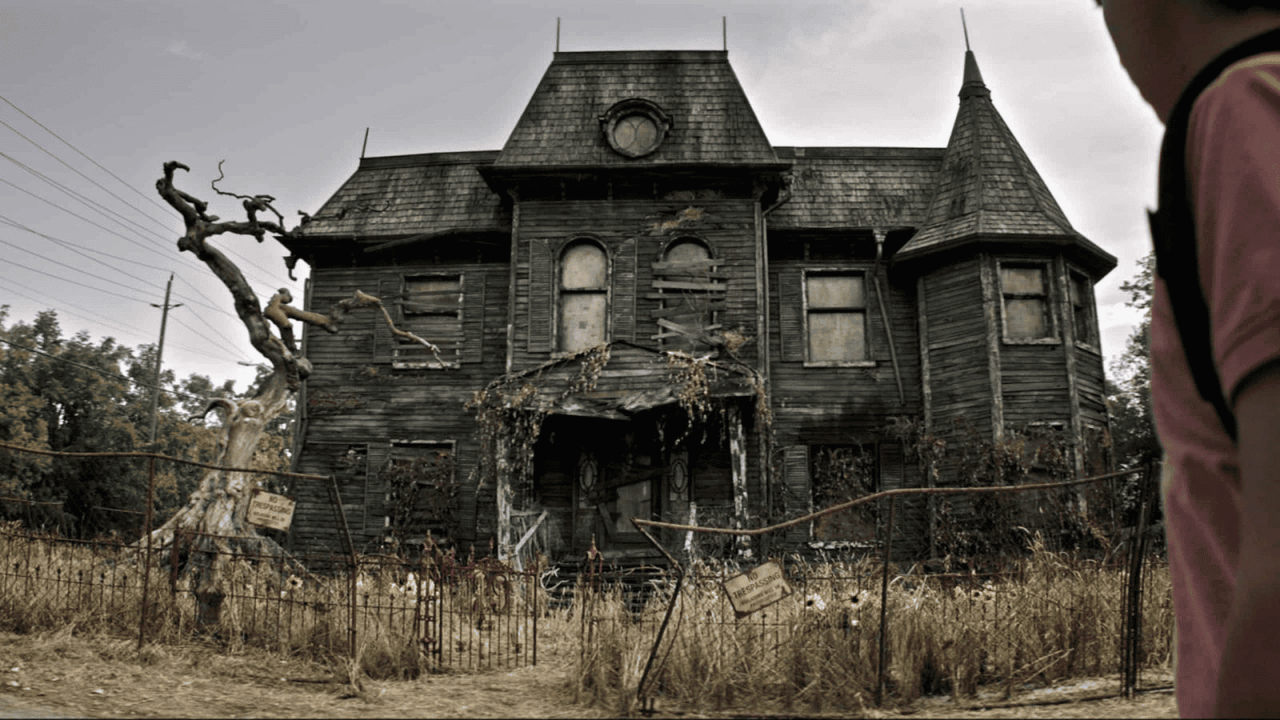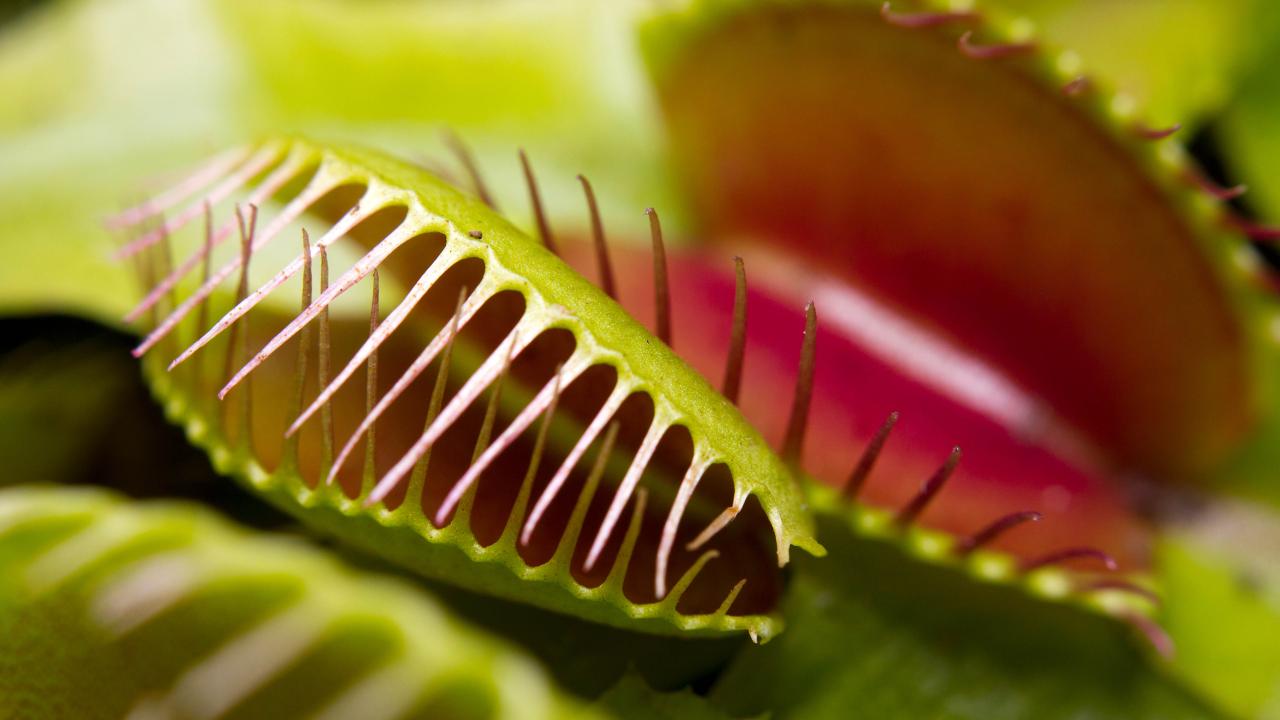Halloween Houseplants That Look Like They Came From a Horror Movie – conjuring up images of creepy crawlies and eerie shadows, these plants are more than just decorations; they’re a gateway to a world of spooky ambiance. From the spidery tendrils of the Venus Flytrap to the ghostly white blooms of the Corpse Flower, these plants offer a unique and unsettling charm, transforming your home into a haunted haven.
Imagine your guests entering your home, greeted by a tableau of these peculiar plants, each whispering tales of horror movie lore.
This article will explore the world of these spooky houseplants, highlighting their unique characteristics, care requirements, and the horror movie connections that make them so captivating. We’ll delve into their fascinating folklore and legends, offering insights into their spooky aura and how to use them to create a truly chilling Halloween display.
Additionally, we’ll address plant safety concerns, ensuring you can enjoy these macabre beauties while prioritizing the well-being of your family and pets.
Spooky Plant Choices
Transform your home into a spine-chilling sanctuary this Halloween with these eerie houseplants that will make your guests feel like they’ve stepped into a horror movie. From plants that resemble skeletal hands to those that look like they’ve sprung from a graveyard, these botanical oddities will add a touch of the macabre to your decor.
Eerie Houseplants Inspired by Horror Films
These plants are not only visually striking but also offer a unique opportunity to engage with the world of horror through the lens of nature.
-
Venus Flytrap
The Venus flytrap ( Dionaea muscipula) is a carnivorous plant that has long been associated with horror movies. Its trap-like leaves, lined with sharp teeth, snap shut quickly to capture unsuspecting insects. This plant’s predatory nature and gruesome appearance make it a perfect choice for any Halloween display.
While some Halloween houseplants exude a spooky charm, others are downright terrifying. Think Venus flytraps with their snapping jaws or the menacing black bat plant with its eerie foliage. If you’re looking for a less demanding, but still spooky, option, consider the Easiest Halloween Houseplants to Care for During the Fall.
These low-maintenance plants, like the spider plant or the snake plant, can add a touch of creepy crawly ambiance without requiring a master’s degree in botany.
In the 1982 horror film The Thing, a parasitic alien organism takes on the form of a variety of creatures, including a Venus flytrap, which it uses to lure and devour its victims.
-
Black Mondo Grass
Black mondo grass ( Ophiopogon planiscapus‘Nigrescens’) is a striking plant with deep black leaves that resemble long, slender fingers reaching up from the soil. Its dark, almost eerie appearance evokes a sense of mystery and intrigue.
The film The Sixth Sense(1999) features a scene where a young boy, Cole, encounters a ghostly figure in a graveyard. The scene takes place amongst a backdrop of dark, shadowy trees, which could be interpreted as black mondo grass, adding to the film’s unsettling atmosphere.
-
Ghost Plant
The ghost plant ( Graptopetalum paraguayense) is a succulent with pale, translucent leaves that appear almost ghostly. The plant’s delicate, ethereal appearance, coupled with its pale coloration, gives it a haunting and spectral quality.
The film The Others(2001) features a haunted house filled with shadowy figures and eerie noises. The ghostly ambiance of the film could be amplified by the presence of ghost plants, their pale leaves blending seamlessly into the dimly lit rooms.
-
Dragon Tree
The dragon tree ( Dracaena draco) is a striking plant with thick, fleshy leaves that grow in a rosette pattern. Its dark green leaves, combined with its sturdy trunk, give it a somewhat menacing appearance, reminiscent of a mythical dragon.
The film The Hobbit: An Unexpected Journey(2012) features a scene where the characters encounter a giant dragon, Smaug, who is guarding a treasure hoard. The dragon’s imposing presence is echoed in the dragon tree’s strong and imposing form.
-
Staghorn Fern
The staghorn fern ( Platycerium) is an epiphytic fern with large, antler-like fronds that grow from a central base. The plant’s unique form, reminiscent of a deer’s antlers, lends itself to a spooky or eerie aesthetic.
The film The Evil Dead(1981) features a scene where the main characters are terrorized by demonic entities in a remote cabin in the woods. The film’s atmosphere of dread and isolation could be heightened by the presence of staghorn ferns, their antler-like fronds adding to the sense of unease.
-
Bat Plant
The bat plant ( Tacca chantrieri) is a tropical plant with dark purple flowers that resemble bats in flight. Its unusual shape and dark coloration give it a mysterious and even slightly sinister appearance.
The film Bram Stoker’s Dracula(1992) features a scene where Count Dracula, a vampire, emerges from his coffin in a dark, shadowy room. The scene could be enhanced by the presence of bat plants, their dark flowers adding to the film’s gothic atmosphere.
-
Skeleton Plant
The skeleton plant ( Monstera deliciosa) is a tropical vine with large, deeply lobed leaves that resemble a skeleton’s ribcage. Its unique leaf shape and large size create a dramatic and somewhat unsettling effect.
The film The Silence of the Lambs(1991) features a scene where the main character, Clarice Starling, visits the home of a serial killer, Hannibal Lecter. The film’s unsettling atmosphere could be heightened by the presence of a skeleton plant, its skeletal leaves adding to the sense of unease.
-
Snake Plant
The snake plant ( Sansevieria trifasciata) is a hardy houseplant with stiff, upright leaves that resemble snakes. Its dark green leaves and pointed tips give it a somewhat threatening appearance.
The film Anaconda(1997) features a scene where a group of filmmakers are terrorized by a giant anaconda snake in the Amazon rainforest. The film’s sense of danger and suspense could be amplified by the presence of snake plants, their snake-like leaves adding to the film’s chilling atmosphere.
-
Spider Plant
The spider plant ( Chlorophytum comosum) is a common houseplant with long, slender leaves that resemble spider legs. Its delicate, almost ethereal appearance, coupled with its tendency to produce spiderettes (baby plants), gives it a somewhat creepy or eerie quality.
The film Arachnophobia(1990) features a scene where a group of people are terrorized by deadly spiders that have invaded their small town. The film’s atmosphere of fear and paranoia could be heightened by the presence of spider plants, their spider-like leaves adding to the film’s unsettling atmosphere.
-
Black Coral Plant
The black coral plant ( Acalypha wilkesiana‘Black Coral’) is a striking plant with dark purple leaves that have a velvety texture. Its dark coloration and unique leaf shape give it a mysterious and somewhat eerie appearance.
The film The Blair Witch Project(1999) features a scene where the main characters, a group of student filmmakers, are lost in the woods and begin to experience strange and unsettling events. The film’s atmosphere of dread and uncertainty could be enhanced by the presence of black coral plants, their dark leaves adding to the film’s haunting ambiance.
Plant Care and Maintenance
Keeping your Halloween houseplants alive and thriving throughout the spooky season requires a bit of care and attention. Like any other plant, they need the right amount of light, water, and nutrients to flourish. This section will discuss the specific care requirements for each chosen plant, along with tips for keeping them healthy and addressing common issues.
Light Requirements
The amount of light each plant needs varies. Some prefer bright, indirect light, while others thrive in low-light conditions. Here’s a breakdown of light preferences for each plant:
- Black Mondo Grass:This plant thrives in shady conditions and prefers indirect light. Direct sunlight can scorch its leaves.
- Purple Shamrock:This plant enjoys bright, indirect light but can tolerate low-light conditions. Avoid placing it in direct sunlight, as it can cause the leaves to fade.
- Venus Flytrap:These carnivorous plants need bright, direct sunlight for at least four hours a day. They thrive in a south-facing window.
- Black Coral Plant:This plant prefers bright, indirect light. Avoid placing it in direct sunlight, as it can cause the leaves to turn brown.
- Black Bat Plant:This plant thrives in bright, indirect light. Direct sunlight can cause the leaves to burn.
Watering
Proper watering is crucial for keeping your Halloween houseplants healthy. Here’s a guide to watering each plant:
- Black Mondo Grass:This plant prefers moist soil but doesn’t like to be waterlogged. Allow the top inch of soil to dry out before watering again.
- Purple Shamrock:This plant needs consistent moisture. Water it when the top inch of soil feels dry. Don’t let the soil dry out completely.
- Venus Flytrap:These plants require distilled or rainwater, as tap water can contain harmful minerals. Water them when the soil feels dry to the touch. Avoid overwatering, as it can lead to root rot.
- Black Coral Plant:This plant prefers moist soil but doesn’t like to be waterlogged. Allow the top inch of soil to dry out before watering again.
- Black Bat Plant:This plant enjoys consistent moisture. Water it when the top inch of soil feels dry. Don’t let the soil dry out completely.
Fertilizing
Fertilizing your Halloween houseplants can help them grow strong and healthy. Here’s a guide to fertilizing each plant:
- Black Mondo Grass:This plant doesn’t need much fertilizer. Fertilize it once a month during the growing season with a balanced liquid fertilizer diluted to half strength.
- Purple Shamrock:This plant benefits from regular fertilization. Fertilize it every two weeks during the growing season with a balanced liquid fertilizer diluted to half strength.
- Venus Flytrap:These plants don’t need fertilizer. They get their nutrients from the insects they catch.
- Black Coral Plant:This plant doesn’t need much fertilizer. Fertilize it once a month during the growing season with a balanced liquid fertilizer diluted to half strength.
- Black Bat Plant:This plant benefits from regular fertilization. Fertilize it every two weeks during the growing season with a balanced liquid fertilizer diluted to half strength.
Common Issues
Like any other plant, your Halloween houseplants can be susceptible to pests and diseases. Here are some common issues and how to address them:
Pests
- Mealybugs:These small, white, cottony insects can infest your plants, sucking the sap from their leaves. To control mealybugs, you can use a cotton swab dipped in rubbing alcohol to remove them. You can also use insecticidal soap or neem oil to treat the infestation.
- Spider Mites:These tiny mites spin webs on the undersides of leaves and feed on plant sap. To control spider mites, you can use a strong jet of water to dislodge them. You can also use insecticidal soap or neem oil to treat the infestation.
- Aphids:These small, soft-bodied insects can infest your plants, sucking the sap from their leaves. To control aphids, you can use a strong jet of water to dislodge them. You can also use insecticidal soap or neem oil to treat the infestation.
Diseases
- Root Rot:This fungal disease can occur when the soil is too wet. To prevent root rot, make sure your plants are in well-draining soil and avoid overwatering. If your plant shows signs of root rot, you may need to repot it in fresh soil.
- Leaf Spot:This fungal disease can cause brown or black spots on the leaves. To prevent leaf spot, avoid getting water on the leaves and provide good air circulation around your plants. If your plant shows signs of leaf spot, you can remove the affected leaves and treat the plant with a fungicide.
- Powdery Mildew:This fungal disease can cause a white, powdery coating on the leaves. To prevent powdery mildew, provide good air circulation around your plants and avoid overwatering. If your plant shows signs of powdery mildew, you can remove the affected leaves and treat the plant with a fungicide.
Creating a Halloween-Themed Display
Transforming your home into a spooky sanctuary is easier than you think, especially with the help of these chillingly beautiful plants. Creating a Halloween-themed display with these plants is a fun and creative way to embrace the spooky season.
Designing a Spooky Plant Display
A table with four columns will help to visualize the perfect spooky plant display. Each column will represent a different aspect of the display: the plant, its common name, its horror movie connection, and a brief care tip.
Plant |
Common Name |
Horror Movie Connection |
Care Tip |
|---|---|---|---|
Dracaena marginata |
Dragon Tree |
Resembles the mythical dragon, often depicted in fantasy and horror films |
Water only when the soil is dry |
Monstera deliciosa |
Swiss Cheese Plant |
Large, split leaves evoke the feeling of a monster lurking in the shadows |
Maintain high humidity |
Sansevieria trifasciata |
Snake Plant |
Long, sharp leaves resemble snakes, often used as a symbol of danger in horror films |
Tolerant of low light and infrequent watering |
Alocasia macrorrhizos |
Elephant Ear Plant |
Large, prominent leaves resemble elephant ears, often associated with large, menacing creatures in horror films |
Keep soil moist but not soggy |
Choosing the Right Decorations
To enhance the spooky ambiance, complement these plants with Halloween-themed decorations. Consider adding:
- Cobwebs: Drape cobwebs around the plants for a classic, eerie effect.
- Skulls: Place miniature skulls amongst the plants, adding a touch of macabre.
- Miniature Pumpkins: Scatter miniature pumpkins around the base of the plants for a festive touch.
- Candles: Use battery-operated candles to create a soft, flickering glow, enhancing the spooky atmosphere.
- Black Feathers: Scatter black feathers around the plants, adding a mysterious and ominous touch.
Arranging the Plants and Decorations
Arranging the plants and decorations is key to creating a visually impactful display.
- Group the plants together: Create a focal point by clustering the plants in a central location.
- Vary heights and textures: Use a combination of tall and short plants, along with textured decorations, to create visual interest.
- Embrace asymmetry: Avoid symmetry for a more natural and organic feel. Place the plants and decorations in a slightly uneven manner.
- Use lighting: Strategically place lighting to highlight the plants and decorations, creating dramatic shadows and enhancing the spooky atmosphere.
Plant Safety and Toxicity

While these plants contribute to a spooky ambiance, it’s essential to consider their safety, especially if you have pets or children. Some of these plants can be toxic if ingested, causing various symptoms ranging from mild irritation to more severe reactions.
Safety Precautions
To ensure a safe Halloween display, it’s crucial to be aware of the potential risks associated with these plants and take necessary precautions.
- Placement:Keep these plants out of reach of children and pets. Consider placing them on high shelves or in areas where they can’t be easily accessed.
- Supervision:Supervise children and pets closely when they are near these plants. Encourage them to avoid touching or playing with them.
- Education:Educate children about the potential dangers of these plants and teach them not to put them in their mouths.
Preventing Accidental Ingestion, Halloween Houseplants That Look Like They Came From a Horror Movie
Preventing accidental ingestion is crucial to avoid potential health issues. Here are some tips:
- Plant Selection:Choose non-toxic alternatives whenever possible. Many plants resemble the spooky aesthetic without posing a risk.
- Clear Labeling:Clearly label all plants with their scientific names and any potential toxicity warnings.
- Secure Containers:Store these plants in sturdy, child-proof containers or enclosures to prevent accidental access.
First Aid and Emergency Measures
In case of accidental ingestion or contact, it’s important to act promptly.
- Contact Poison Control:If you suspect ingestion, contact the local poison control center immediately. They can provide guidance and advice based on the specific plant involved.
- Seek Medical Attention:In case of severe reactions, such as difficulty breathing or swelling, seek immediate medical attention.
- Keep Plant Samples:If possible, bring a sample of the plant to the doctor or poison control center for identification.
Plant Folklore and Legends

Beyond their visually striking appearance, many of these Halloween-themed plants carry a rich history of folklore and legends that contribute to their eerie aura. These legends, often passed down through generations, add a layer of mystery and intrigue, making them perfect for enhancing the horror movie theme of your display.
Looking for some spooky greenery to enhance your Halloween decor? Consider these Halloween Houseplants That Look Like They Came From a Horror Movie. For a truly terrifying touch, explore the world of Halloween Houseplants and choose species with gnarled branches, spiky leaves, or eerie blooms.
These plants will add an authentically macabre vibe to your home, transforming it into a spooky haven for the holiday.
Plant Folklore and Legends
The folklore surrounding these plants often reflects their unique characteristics, such as their dark foliage, unusual growth habits, or even their perceived medicinal properties.
- Black Mondo Grass:This plant, with its deep black leaves, is often associated with mourning and death in some cultures. It’s believed that the plant’s dark color symbolizes the passage to the underworld, making it a popular choice for cemeteries and memorial gardens.
The plant’s somber appearance, reminiscent of a graveyard, adds a chilling touch to any Halloween display.
- Ghost Plant:Also known as -Monotropa uniflora*, this plant lacks chlorophyll and obtains its nutrients from fungi, giving it a pale, ghostly appearance. The plant’s lack of color and its reliance on other organisms for sustenance has led to its association with spirits and the unseen world.
In some folklore, it’s believed that the plant can guide lost souls or even communicate with the dead.
- Ravenala Madagascariensis (Traveller’s Palm):This striking plant, with its fan-like leaves resembling a giant hand, has been linked to various legends and beliefs. In some cultures, it’s considered a symbol of good luck and protection, while others associate it with spirits and the supernatural.
The plant’s unique appearance and the stories surrounding it make it a captivating centerpiece for a Halloween display.
End of Discussion

With a touch of macabre and a sprinkle of horticultural know-how, these Halloween houseplants can transform your home into a spine-tingling haven. From the dramatic silhouette of the Dragon Tree to the eerie glow of the Ghost Plant, each plant brings a unique touch of horror to your Halloween décor.
Remember to prioritize safety, and embrace the unsettling charm of these plants, letting their spooky aura transport you to a world of chilling delights.
Key Questions Answered: Halloween Houseplants That Look Like They Came From A Horror Movie
Are these plants difficult to care for?
While some of these plants might require specific care, many are relatively easy to maintain, especially if you’re familiar with basic houseplant care. This article will provide detailed care tips for each plant, ensuring you can keep them thriving throughout the Halloween season.
Where can I purchase these plants?
Many of these plants can be found at local nurseries, garden centers, and online plant retailers. Some specialty plant stores may also carry a wider selection of unique and unusual plants.
What are some alternative Halloween plants that I can use?
If you’re looking for alternative Halloween plants, consider those with dark foliage, spiky leaves, or unusual textures. Some examples include the Black Mondo Grass, the Snake Plant, and the Black Prince Echeveria.
